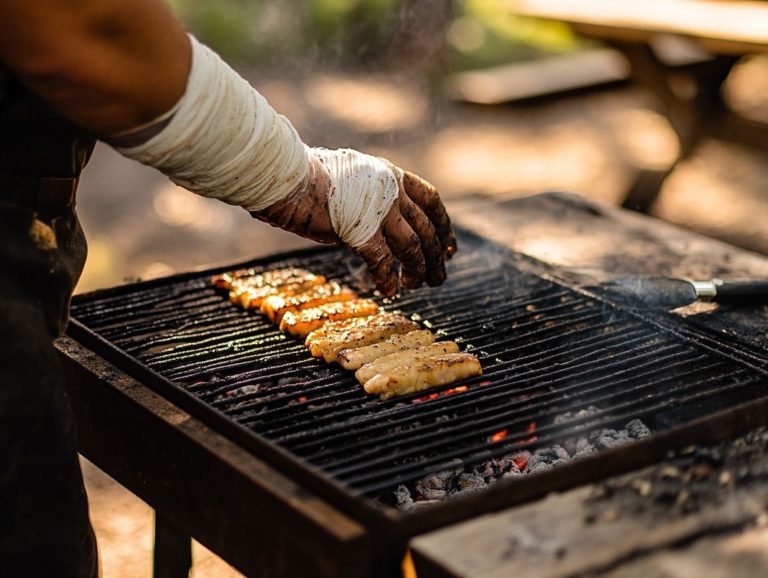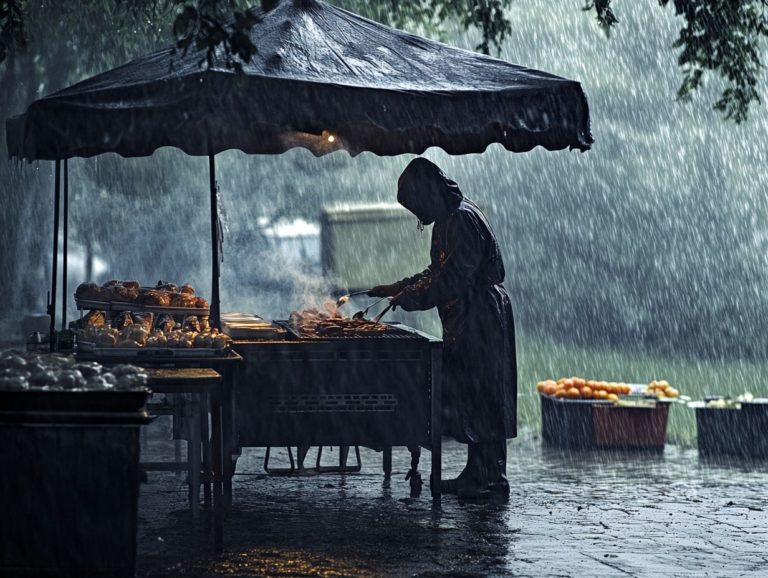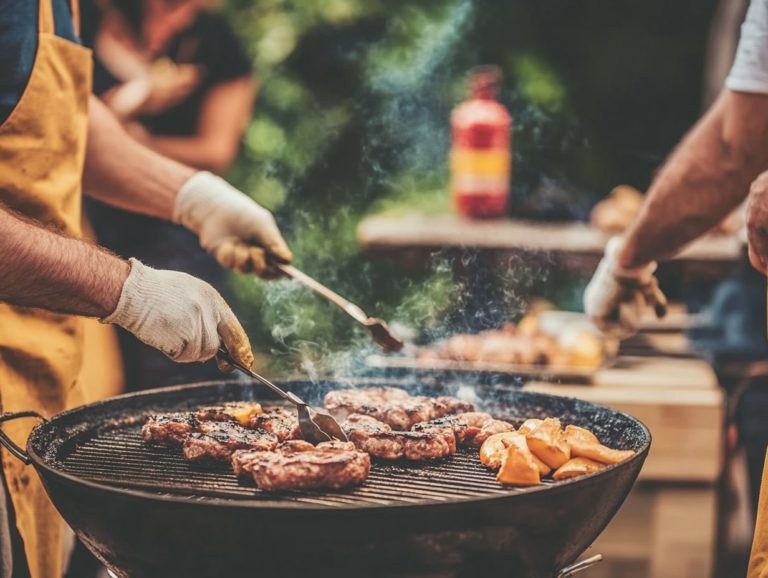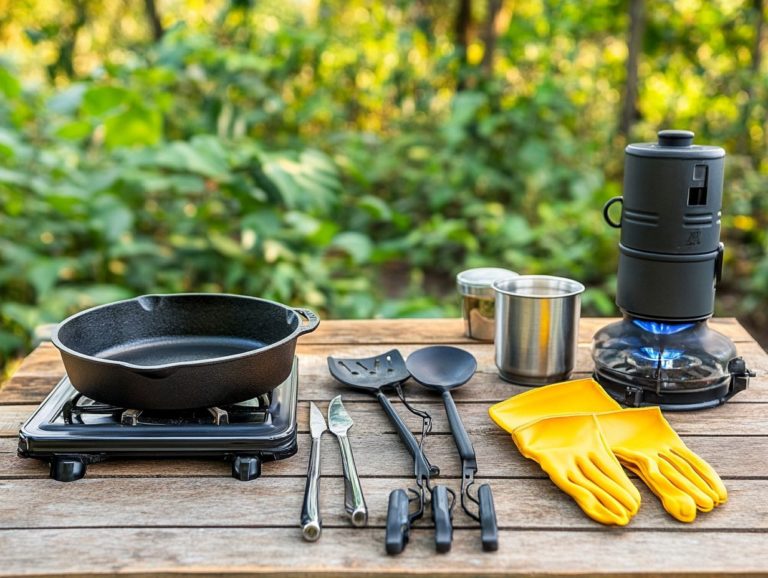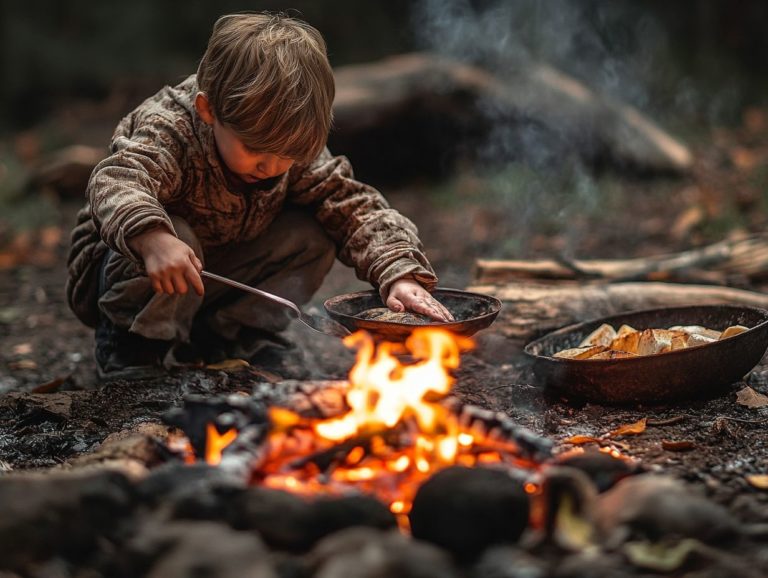5 Ways to Ensure Clean Cooking Surfaces Outdoors
Creating a safe and enjoyable outdoor cooking experience begins with cleanliness. Whether grilling burgers or preparing a picnic, keep your cooking surface clean. This is vital for food safety and quality.
We will address common pitfalls. You ll also learn how often to clean your surfaces. Get ready to transform your outdoor cooking into a safe and fun adventure!
Contents
- Key Takeaways:
- 1. Use a Clean Cooking Surface
- 2. Keep Your Cooking Area Clear of Debris
- 3. Use Separate Cutting Boards for Raw and Cooked Foods
- 4. Clean and Sanitize Your Cooking Tools and Utensils
- 5. Properly Store Food and Leftovers
- Why Is It Important to Keep Cooking Surfaces Clean Outdoors?
- What Are the Dangers of Cooking on a Dirty Surface?
- What Are the Best Cleaning Products to Use for Outdoor Cooking Surfaces?
- What Are Some Tips for Cleaning Hard-to-Reach Areas on an Outdoor Cooking Surface?
- How Often Should Outdoor Cooking Surfaces Be Cleaned?
- What Are Some Common Mistakes People Make When Cleaning Outdoor Cooking Surfaces?
- Frequently Asked Questions
- How can I ensure clean cooking surfaces outdoors?
- Why is it important to keep cooking surfaces clean while cooking outdoors?
- What can I use to clean the grill grates?
- How often should I clean my outdoor cooking surfaces?
- Can I use the same cutting board for raw meat and other foods?
- What should I do if there are grease or food spills on my outdoor cooking surfaces?
Key Takeaways:
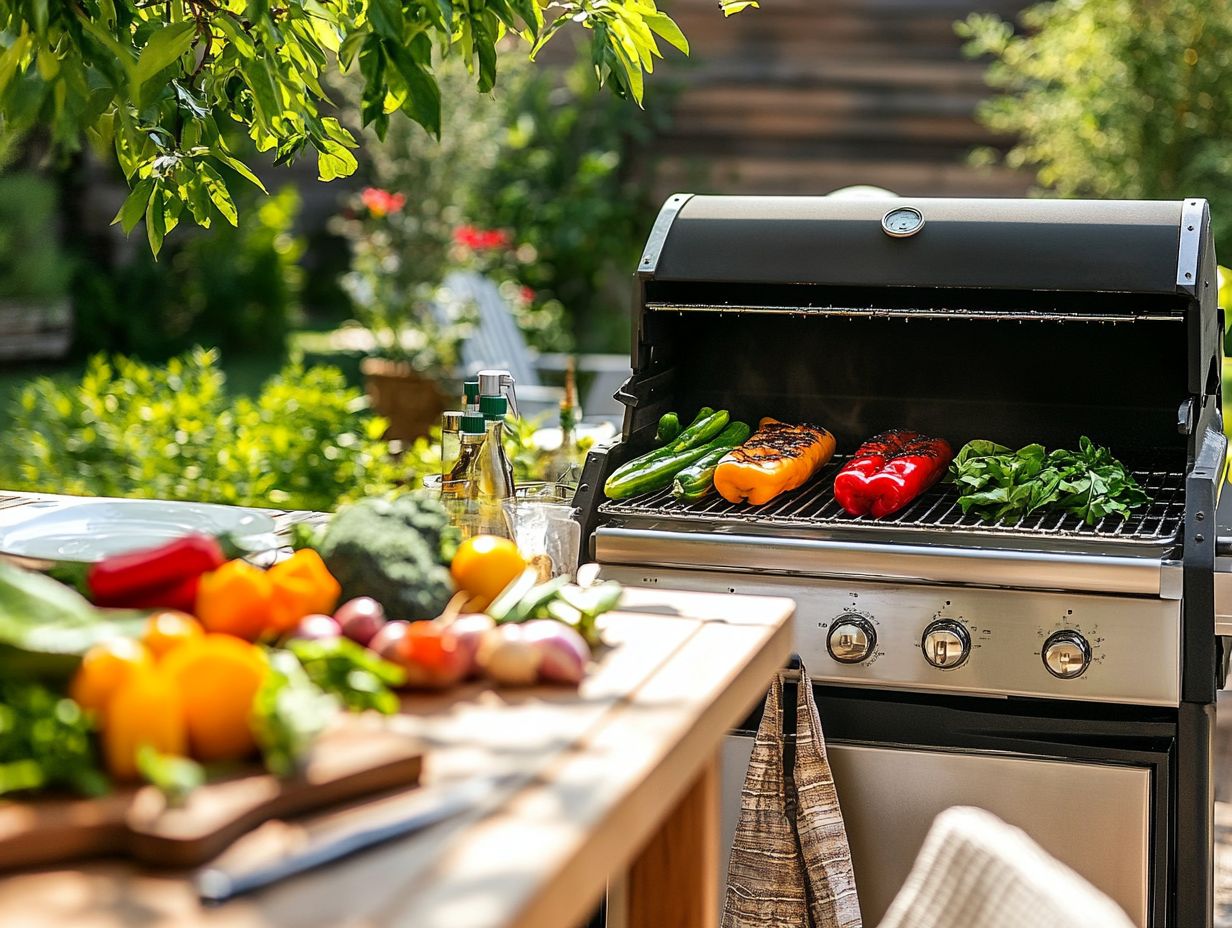
- Start with a clean cooking surface to keep food safe and delicious.
- Regularly clear debris to create a pest-free space!
- Use separate cutting boards for raw and cooked foods to prevent the spread of harmful bacteria.
1. Use a Clean Cooking Surface
A pristine cooking surface is vital for your outdoor kitchen. It elevates your grilling performance while safeguarding against foodborne illness by reducing the risk of bacteria growth and food contamination during meal prep. To ensure safety while cooking outside, learn how to set up a safe cooking zone outdoors.
Keeping surfaces like your stainless steel grills and wooden countertops free from residues and contaminants is essential for food safety. Regularly cleaning these appliances with the right solutions, such as vinegar or specialized grill cleaners, effectively eradicates harmful bacteria.
Scrubbing with easy-to-clean brushes and thoroughly drying surfaces not only maintains hygiene but also extends the lifespan of these materials. By adopting these practices and learning how to maintain your outdoor cooking equipment, you can transform outdoor cooking into a safer and more enjoyable experience, allowing you to focus on creating delightful meals with friends and family.
2. Keep Your Cooking Area Clear of Debris
Maintaining a clear cooking area in your outdoor kitchen is essential for effective food preparation and creating a safe environment. It reduces the risk of accidents and food contamination.
To achieve this, it’s important to remove clutter, debris, and any outdated outdoor furniture. A streamlined space not only elevates the aesthetic appeal but also enhances efficiency during meal prep.
Establishing a routine outdoor maintenance schedule can greatly contribute to preserving a clean cooking area. Regularly checking for items that accumulate over time such as old utensils, broken chairs, or even leaves and dirt will help you sustain an organized environment.
Investing in proper storage solutions, like weather-resistant cabinets or stylish storage bins, can keep your space tidy and functional while ensuring the proper care and safe storage of your cooking utensils.
3. Use Separate Cutting Boards for Raw and Cooked Foods
Using separate cutting boards for raw and cooked foods is a crucial hygiene practice. It helps prevent foodborne illnesses and ensures that your outdoor cooking activities are safe and enjoyable.
This practice minimizes cross-contamination and preserves the integrity of flavors in your dishes. By using separate boards, you significantly reduce the risk of harmful bacteria from raw meats making their way to ready-to-eat items, protecting everyone s health.
It’s wise to choose plastic boards for raw meats, as they are easy to clean and can be sanitized in the dishwasher. Wooden boards are perfect for bread and vegetables, thanks to their natural antimicrobial properties that help keep food fresher.
Regularly oiling your wooden boards and cleaning your plastic ones with hot, soapy water will extend their lifespan. This ensures that your outdoor cooking remains a delightful experience filled with grilling safety.
4. Clean and Sanitize Your Cooking Tools and Utensils
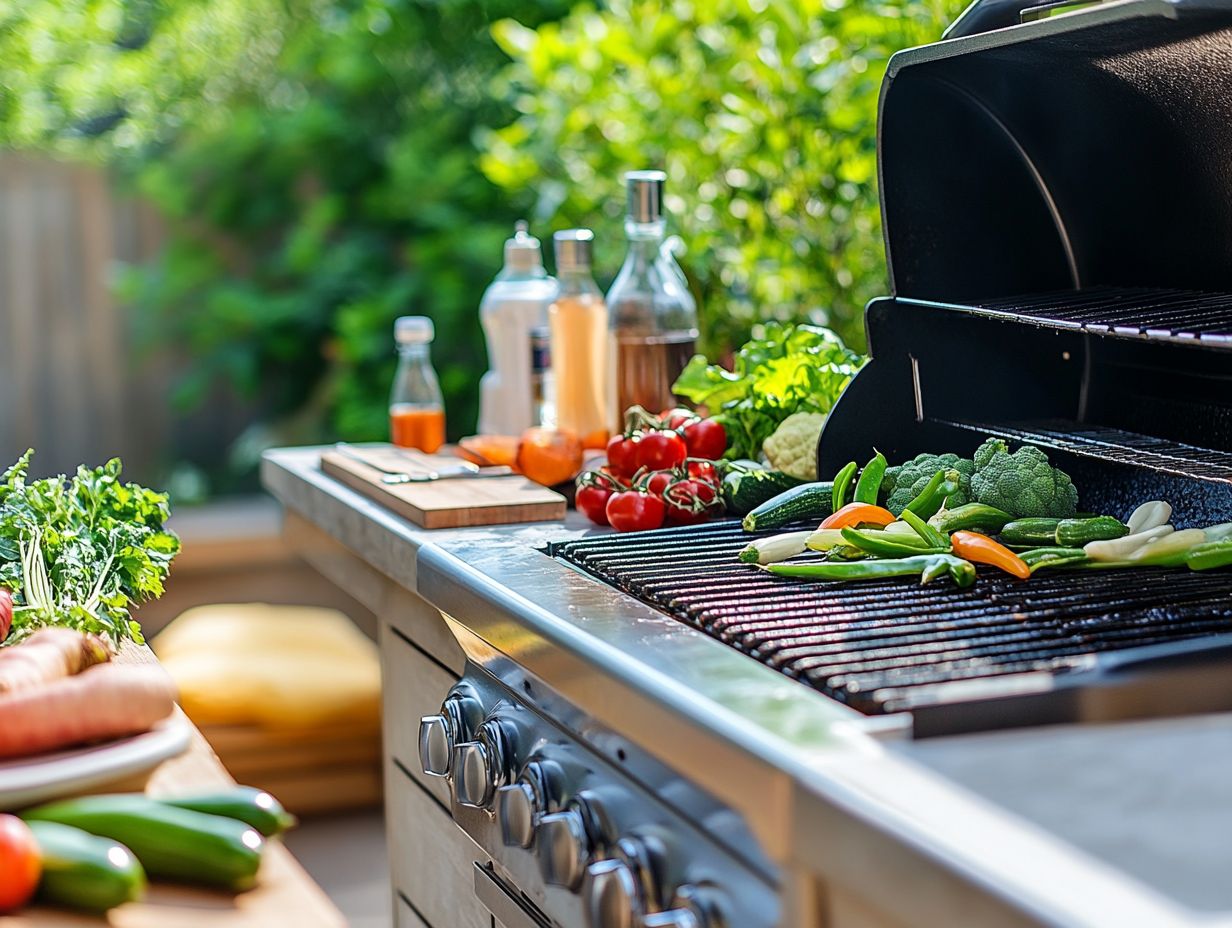
Effective cleaning and sanitization of your cooking tools and utensils are crucial for creating a hygienic outdoor cooking environment. This helps prevent bacteria growth and ensures food safety during your outdoor gatherings.
To achieve this, consider using food-safe cleaning products, like vinegar-based solutions or biodegradable soaps. These options not only break down grease effectively but are also safe for surfaces that come into contact with food.
Make sure to wash your cutting boards thoroughly! This step is vital for keeping your meals safe and tasty. Use hot, soapy water and rinse everything thoroughly to eliminate any residue.
Regular maintenance is key; inspect your tools for wear and tear to ensure their surfaces remain intact and effective. After cleaning, sanitizing with a chlorine solution can help eliminate any lingering pathogens, promoting best practices in sanitation that align with food hygiene standards.
5. Properly Store Food and Leftovers
Proper food storage and handling of leftovers in your outdoor kitchen is essential to prevent food contamination and ensure that every meal remains safe and enjoyable for all, especially during outdoor living activities.
To maintain food safety, it’s crucial to use well-sealed containers. These not only keep your foods fresh but also prevent the mixing of different food items, which is a serious concern.
Regularly monitoring the temperature inside your refrigerators is key. Aim to keep them at or below 40 F to inhibit the growth of harmful bacteria.
Organizing your food items by prioritizing those with earlier expiration dates will also help you minimize waste.
Using ice packs or coolers in outdoor settings enhances temperature control, allowing you and your guests to savor delicious meals without the worry of foodborne illness during your camping activities.
Why Is It Important to Keep Cooking Surfaces Clean Outdoors?
Keeping your outdoor cooking surfaces spotless is essential for many reasons. It significantly reduces the risk of food contamination, enhances the overall safety of your cooking activities, and minimizes the potential growth of bacteria that could lead to foodborne illnesses. Additionally, following proper guidelines can help, such as these 5 ways to stay safe while cooking over a campfire during your gatherings.
A pristine surface is vital for preserving the integrity of the flavors in your dishes. When residues from previous meals linger, they can sully the taste of fresh ingredients, undermining your culinary experience.
Emphasizing hygiene while cooking outdoors not only cultivates a healthier environment but also promotes best practices in food handling. This instills confidence among your guests, allowing everyone to savor the meal with peace of mind.
Ultimately, the connection between cleanliness and food hygiene is crucial. It elevates your outdoor cooking from a simple activity to a safe and delightful experience, especially when incorporating grilling tips.
What Are the Dangers of Cooking on a Dirty Surface?
Did you know that cooking on a dirty surface can lead to serious health risks? Cooking on a dirty surface presents considerable dangers, particularly the heightened risk of foodborne illnesses and bacteria contamination, which can compromise the safety of your meals during outdoor cooking.
This concern is especially pertinent when you consider that many bacteria, such as Salmonella and E. coli, flourish in unclean environments. It’s quite alarming to note that approximately 48 million people in the U.S. are affected by foodborne illnesses each year, leading to around 128,000 hospitalizations.
Neglecting proper hygiene practices during meal preparation not only enables harmful bacteria to thrive but also increases the likelihood of transferring these pathogens to your food. Regularly disinfecting surfaces and washing your hands can significantly mitigate these risks, transforming your dining experience into a much safer affair.
What Are the Best Cleaning Products to Use for Outdoor Cooking Surfaces?
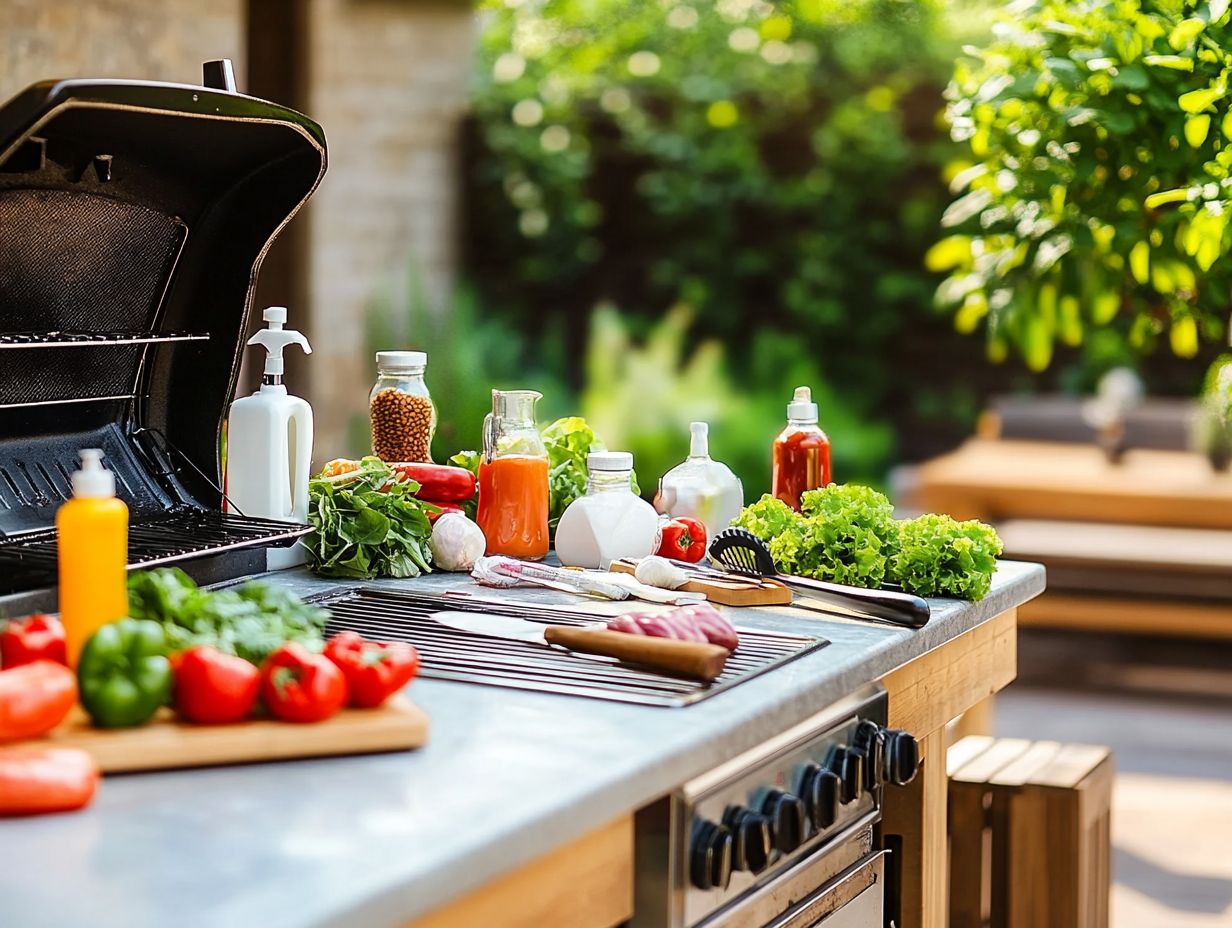
Choosing the right cleaning products for your outdoor cooking surfaces is crucial for effectively eliminating grease, grime, and harmful bacteria. This also extends the life of your outdoor kitchen appliances, ensuring proper kitchen maintenance.
Using the right products can dramatically enhance your ability to maintain a safe and hygienic cooking environment for delightful al fresco meals. For stainless steel surfaces, opt for a specialized cleaner that prevents streaks and preserves that brilliant shine. If you’re dealing with stubborn stains, a simple mixture of baking soda and water can be an excellent natural remedy.
When it comes to stone or tile elements, use cleaners that won t harm surfaces. Don t underestimate vinegar; its antibacterial properties make it a fantastic choice for various surfaces.
Ultimately, selecting the right product tailored to the specific materials of your outdoor kitchen ensures it remains both functional and visually appealing, enhancing your overall enjoyment of outdoor living.
What Are Some Tips for Cleaning Hard-to-Reach Areas on an Outdoor Cooking Surface?
Cleaning those hard-to-reach areas can be a fun challenge that keeps your cooking space spotless! It’s essential for maintaining food hygiene and preventing bacteria buildup in neglected spots.
For tackling these tricky zones, consider using specialized brushes or scrubbers designed for grill grates. They do wonders in dislodging stubborn grease without scratching the surface.
For your countertops, a microfiber cloth can effortlessly reach into corners and edges, capturing all debris and grime that might otherwise go unnoticed. Mixing vinegar and water in a spray bottle provides a targeted cleaning solution that lifts even the toughest stains without causing damage.
By dedicating time to these often-overlooked areas, you significantly enhance the overall cleanliness and safety of your outdoor cooking experience.
How Often Should Outdoor Cooking Surfaces Be Cleaned?
Establishing a regular cleaning schedule for your outdoor cooking surfaces is essential for maintaining hygiene practices. To further enhance your outdoor meal preparations, make sure to follow guidelines like those found in stay safe: essential tips for outdoor cooking, ensuring that food safety standards are consistently upheld.
Integrating frequent cleaning sessions tailored to the types of meals you prepare and outdoor conditions you face can significantly reduce the risk of foodborne illnesses. For example, clean your surfaces immediately after grilling meats to prevent cross-contamination.
If your outdoor environment attracts dust and allergens, more frequent scrubbing may be necessary to keep everything in pristine condition. Following a structured maintenance schedule promotes cleanliness and extends the life of your equipment.
Ultimately, these practices contribute to a healthier outdoor dining experience, allowing you and your guests to enjoy your time together with peace of mind.
What Are Some Common Mistakes People Make When Cleaning Outdoor Cooking Surfaces?
Many individuals stumble into common pitfalls when cleaning outdoor cooking surfaces. To avoid these issues and ensure safety, it’s essential to learn how to keep your outdoor cooking area safe. These missteps can unintentionally lead to food contamination and compromise food hygiene during outdoor gatherings.
One frequent misstep is using harsh cleaning products that leave behind harmful residues, creating risks when it s time to cook. Overlooking areas like under grill grates or within heat shields allows grease and bacteria to accumulate unnoticed.
To tackle these challenges, choose food-safe cleaning agents and ensure every surface, including tricky spots, receives a thorough scrub. For more information on keeping your cooking area tidy, check out best practices for outdoor cooking clean-up. Regular maintenance, such as a deep clean after heavy use and applying protective covers during storage, upholds hygiene standards and extends the lifespan of your outdoor cooking appliances.
Frequently Asked Questions

How can I ensure clean cooking surfaces outdoors?
To keep your outdoor cooking surfaces clean, follow these five methods:
1) Wipe down the surfaces before and after cooking. 2) Use a grill brush to clean the grates. 3) Cover the surfaces with aluminum foil for easy cleanup. 4) Use a separate cutting board for raw meat. 5) For comprehensive guidance, follow these 5 ways to ensure safe cleanup after outdoor cooking and clean up any spills right away.
Why is it important to keep cooking surfaces clean while cooking outdoors?
Keeping cooking surfaces clean is crucial for several reasons.
It prevents the mixing of raw meat with other foods, which helps avoid foodborne illnesses. Clean surfaces also maintain the taste and quality of your meals and keep your cooking area safe.
What can I use to clean the grill grates?
The best tool for cleaning grill grates is a sturdy grill brush with wire bristles.
Scrape the grates thoroughly to remove stuck food. For tougher stains, use soapy water with a scrub brush.
How often should I clean my outdoor cooking surfaces?
Clean your outdoor cooking surfaces before and after each use. This practice removes harmful bacteria and prevents buildup, and you can learn more about safe practices by following this guide on how to handle cooking utensils safely outdoors.
For grills, deep cleaning at least once a year is recommended.
Can I use the same cutting board for raw meat and other foods?
No, using the same cutting board for raw meat and other foods is not safe.
It increases the risk of illnesses. Always use separate boards to ensure safe cooking.
What should I do if there are grease or food spills on my outdoor cooking surfaces?
If you see grease or food spills, clean them up immediately.
Use a scraper or paper towels to remove debris, then wipe the area with a damp cloth or soapy water.

